Website & blogs © Louis Kraft 2013-2020
Contact Kraft at writerkraft@gmail.com or comment at the end of the blog
Sand Creek and the Tragic End of a Lifeway
The Sand Creek manuscript differs from my previous nonfiction work in that it features multiple leading players as opposed to one or two.
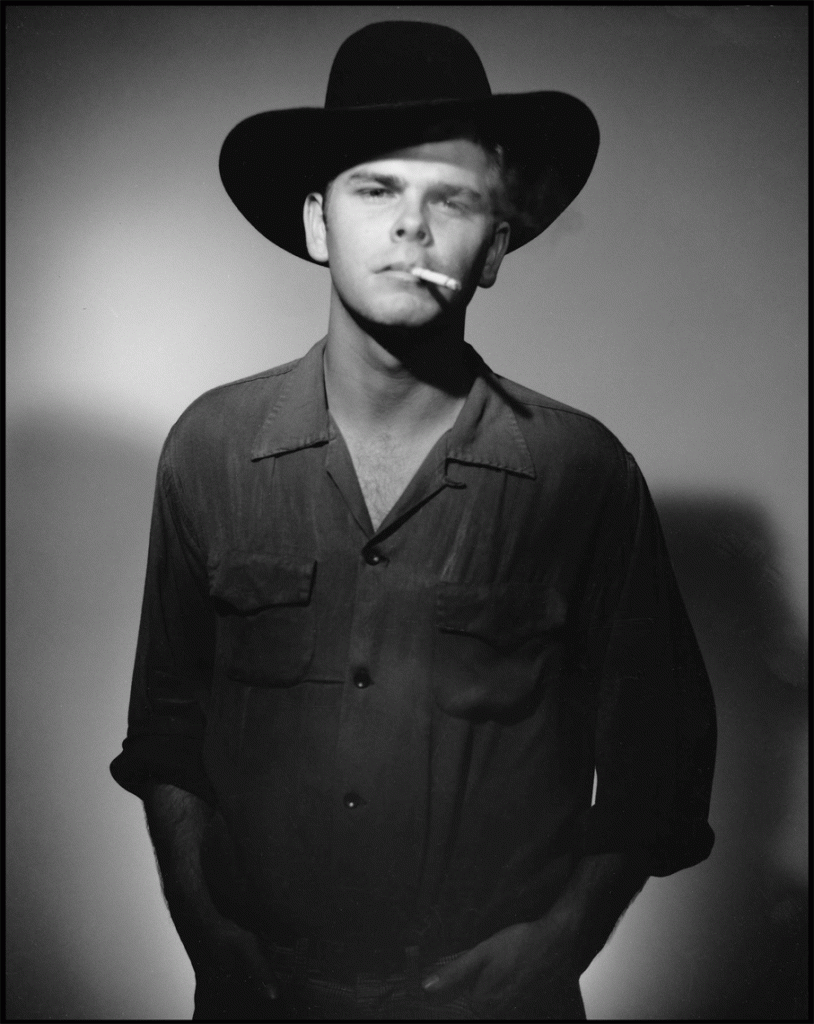
LK in costume as Billy the Kid (sans the revolver and gun belt). A 1969 publicity photo taken by Dennis Riley, who was then a photographer’s mate in the U.S. Navy. This photo session was the first of many over the years. Dennis and I became close during our high school years and this lasted through my four years of college, his college and military service, and after. We were constantly in trouble but he was always there for me and me for him. Those days are long gone. (photo © Louis Kraft 1969)
This includes my written plays in which I have performed. They date back to 1969 with Lew and Billy (Billy the Kid’s meeting with New Mexico Territorial Governor Lew Wallace); 1982’s The Fencing Lesson (a man and a woman cross sabers with deadly intent in a battle of the sexes); the Wynkoop one-man plays that have played in four states, and 2009’s Cheyenne Blood, which again featured two characters—Ned Wynkoop and the Cheyenne woman Mo-nahs-e-tah, who survived bloody attacks on Cheyenne villages (Sand Creek, 1864; and Washita, 1868). This is the phonetic spelling of her name.
Yes, Sand Creek and the Tragic End of a Lifeway is going to be a stretch.
How do I bring the leading players to life? How do I mix and connect the leading players’ story lines? And how do I create text that flows while remaining true to the facts and not putting the readers to sleep?
These are big questions, and they live with me every day.
And of course there are welcome interruptions
In 2001 Fray Angélico Chávez History Library (part of the New Mexico History Museum, Santa Fe) curator Tomas Jaehn (pronounced “Yen”) began the process to create “The Louis Kraft Collection.” A number of years later my then girlfriend Diane Moon wanted to know why Tomas was interested in my work and associated documentation? I told her I didn’t know. “Didn’t you ask?” “No.” “Why not?” I told her that I had been associated with the library since the 1980s, Tomas was interested in my work and letters, and that was good enough for me.
Good enough for me, but not for her.

I met Tomas Jaehn shortly after he replaced Orlando Romero at the New Mexico History Museum. Eventually the archival portion of the museum would be renamed the Chávez History Library. We hit it off immediately. There’s really nothing more to say here other than I’m lucky to know my good friend.
In 2006 I did a 10-day road trip to the Chávez to make an archive delivery and near the end of the trip talk about “Gatewood’s Administration of the White Mountain Indian Reservation” (during the 1880s Lt. Charles Gatewood, 6th U.S. Cavalry, commanded a troop of Apache scouts and administered the Apache reservation headquartered at Fort Apache, Arizona Territory). Diane flew to Albuquerque on July 2 and spent a few days in Santa Fe before flying home on July 5. She met Tomas when I made the delivery on the third.
I knew what was coming. “Why him?” she asked Tomas when he gave her a tour of where and how the collections were preserved. She insisted upon seeing the Louis Kraft Collection. I wasn’t sure what was about to happen, but knew something would. As it turned out Tomas liked my body of work. More important he felt that since a good portion of my work dealt with Gatewood and the Apache wars and Ned Wynkoop and the Cheyennes that it was ideal for the Chávez, which houses the most complete Edward W. Wynkoop Collection.

LK in front of the original entry to the NM History Museum (4jul2006) during the trip to Santa Fe to make a delivery to the archive. This entry still exists but is no longer used to enter the Fray Angélico Chávez History Library. Times have changed, and I think for the better. (photo © Louis Kraft 2006)
Before and since the creation of the archive Tomas has done everything to aid my writing and speaking efforts, as well as help me obtain documents and primary source images. Over the years he and Audrey, his wife, have become good friends.
That July Tomas told me about a primary source Sand Creek battle participant document that the Chávez was considering purchasing from a private collection. I reviewed it for Tomas. During the course of our conversations he said I could use this to-date unused view of events in Sand Creek and the Tragic End of a Lifeway (if the library buys the document; and if not, he thought he could convince the document owner to allow me to use it). Fingers are crossed, as there is information worth sharing. I should know the final outcome soon. Unfortunately I can’t share any details at this time.
**********
George Bird Grinnell completed a massive amount of research over his life documenting American Indians (mostly Cheyennes and Pawnees, but other tribes also). His papers are at the Braun Research Library, Southwest Museum, which is now part of the Autry National Center, Los Angeles, California. The Grinnell Papers take 77 pages to list the folders and diaries. I have 12 days booked at the Braun in the future and have submitted the first round of documents that I must read. Twenty-seven folders and diaries, and this is just the beginning of what I will view before completing my Grinnell research for the Sand Creek manuscript. Earlier I had mined the Grinnell Papers for Ned Wynkoop and the Lonely Road from Sand Creek, but that research centered on Cheyennes that played roles in Wynkoop’s life. I have a fair amount of Grinnell’s writing in-house, but from past experience his research notes are where the gold will be found.
A glimpse into the LK creative world
Add my ongoing high wire act while juggling a life that is so crowded that at times it feels as if I’m being yanked in four directions at the same time.
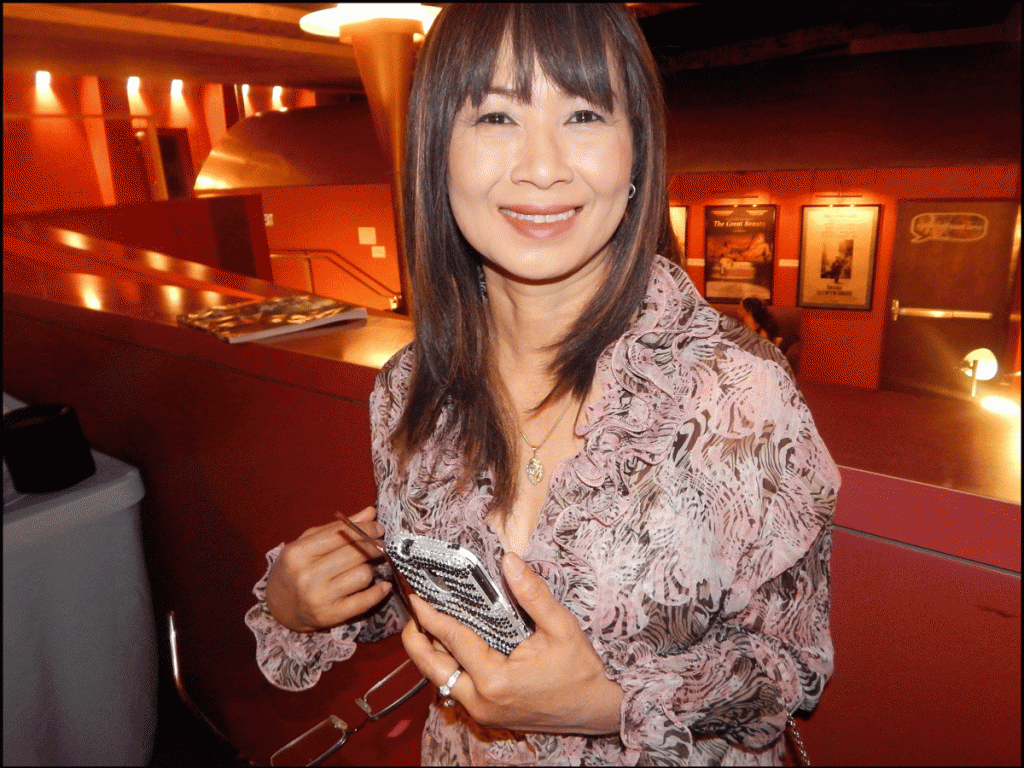
Pailin at the Egyptian Theatre in Hollywood, Ca., on 15may2014 for a screening of Errol Flynn’s last A-film (and his next to last film), the 1958 release of director John Huston’s The Roots of Heaven. I caught a great shot of her here for I was able to eliminate the crowd (the screening was co-sponsored by the French Consulate in LA). Pailin is very aware of my Flynn/de Havilland writing, and this wasn’t my choice for her first complete Flynn film (she had caught the tail end of Adventures of Don Juan and San Antonio when she arrived home from work earlier than expected (and was glued to the TV screen), for I had been carefully plotting her initial introduction to Mr. Flynn’s screen persona. That said I couldn’t refuse seeing Roots on the big screen. At this time Pailin prefers adventures (and is certainly drawn to the American West), but the film has scope and didn’t bore her. BTW, I study film five nights a week. Reason: a writer can learn a lot about plot, character, and dialogue viewing good films. (photo © Pailin Subanna-Kraft & Louis Kraft 2014)
Pailin’s application for a Green Card has been filed and moves forward. This means that I have begun preparing an extensive photo album that shows that she and I are who we claim. At the same time she and I need to prepare carefully for our immigration interviews.
Let’s not forget my writing projects: The Discovery, Errol & Olivia, Sand Creek and the Tragic End of a Lifeway, and that Geronimo article I owe Greg Lalire at Wild West. It now has firm deadline and publication dates. (I will make the deadline if it kills me; unless he takes aim at me first.) In addition to the article I need to complete a portrait of Geronimo that I promised. To date I’ve created two of Mr. G, but don’t like either. This means back to the drawing board. The Flynn projects (E&O + the second book on EF) are major pieces in my life. They must be completed and published. Like Wynkoop, Charles Gatewood, and the Indians and their lives, Mr. Flynn has influenced my life. Actually EF, his film roles and life, have played a major role in my life. Certainly he opened the world of the Indian wars and racism to me.
As the subtitle of my website reads, “Follow the winding trail of a writer as he walks a solitary road …” implies I have spent a lot of time alone. At the same time I’ve never been lonely. Boy, talk about two sentences that state opposites. My friends are good and they are always with me even though most don’t live nearby.
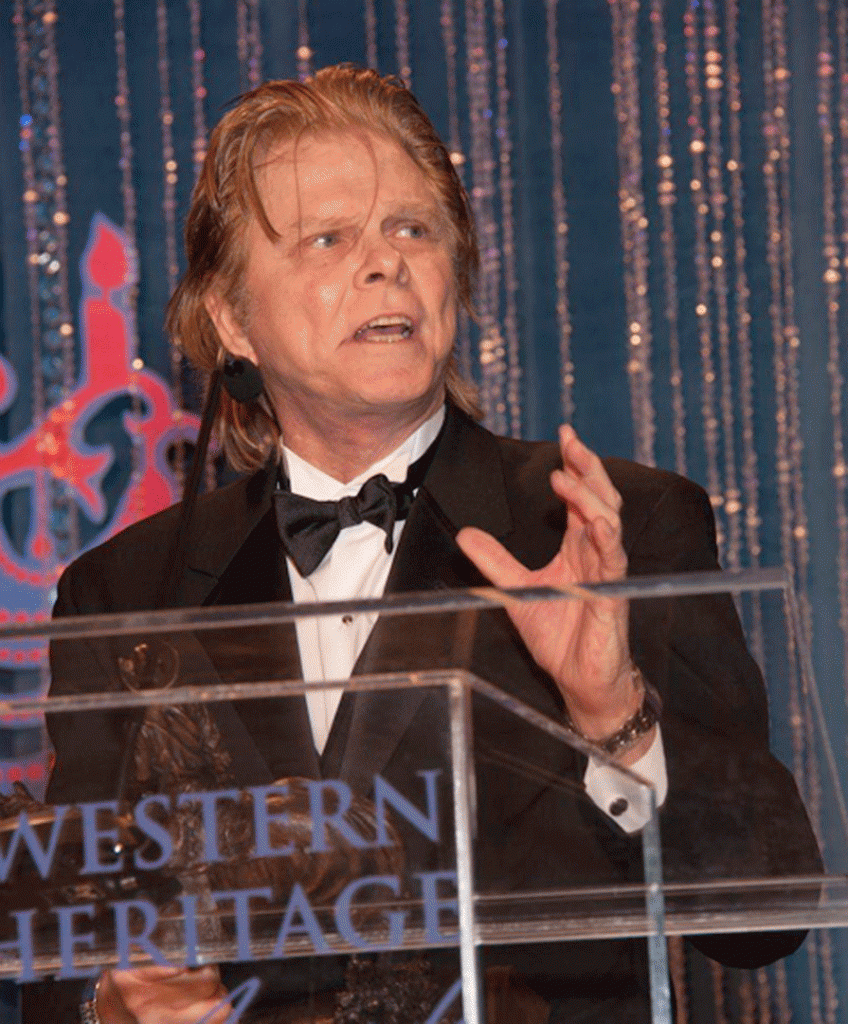
LK at the 2012 Western Heritage Wrangler Awards in OK City. An article of mine, “When Wynkoop was Sheriff,” won a Wrangler. A cool and fun three-day event. (photo © Ownbey Photography 2012)
For me writing is a fight and a struggle. This is a constant, and it is every day. If it weren’t a fight and a struggle why bother? Creativity and finding what is hopefully close to truth doesn’t happen with reading a few facts and then typing a few paragraphs. That’s just the beginning. What has been read may be wrong, which in turn makes my paragraphs wrong. The creativity results from years of not buying into “the easy” or worse “the set premise that must be confirmed at all costs,” but by maintaining an open mind and allowing the discovery of truth and often this isn’t what I expected to find. And this must dictate the story line. Writing, and I don’t care if it in nonfiction, fiction, or whatever, needs a number pieces to work together seamlessly. We’re talking facts, hard cold facts combined with prose that propels the story and doesn’t put the reader to sleep. Sometimes I’ll spend hours on a single paragraph, and if not satisfied more hours. Merging the facts with writing style takes me years to complete, and knowing this has made it mandatory for me to buy into my subjects 100 percent before I write a single word of the manuscript. If I don’t buy into my projects 100 percent, I would walk away from them long before they reached completion.

The Santa Barbara, Ca., art was created in 1977 for my then theatrical manager, Richard Steel Reed. This was a commissioned work (for $300.00), but eventually the art would return to me. The sketch of Patric Spann, was one of many I created for Infonet Services Corporation in the late 1990s when I served as editor-in-chief, art director, designer, staff writer, photographer, and artist for an engineering newsletter that I pitched and created, and which was distributed to Infonet’s offices in 68 countries. A cool job that I had one hell of a lot of fun doing (art © Louis Kraft 1977 & drawing © Louis Kraft 1997)
Over the years I have learned that there are additional ways to add value to the story and bring in extra cash. Money is a necessity. In the past I lived in a world that handed me bags of greenbacks. This allowed me to do whatever I pleased whenever I pleased. Extended research trips with stays in first-class hotels (when available) were the norm.
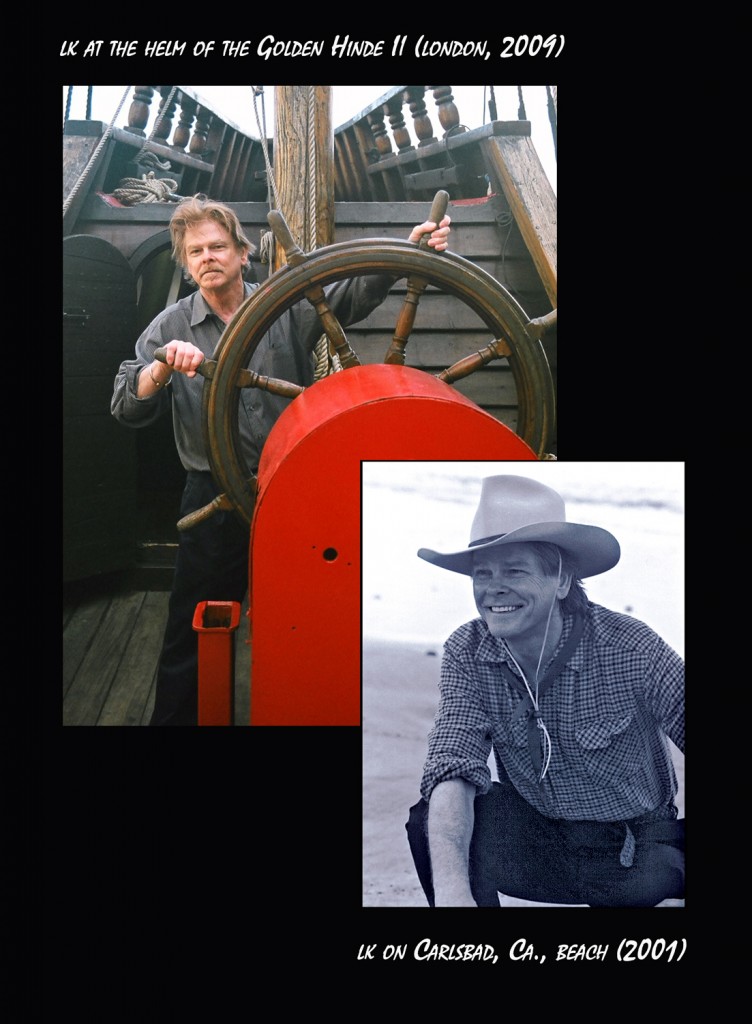
These images represent my wanderlust without a money care. The top image is of me at the helm on the half deck of the pirate Francis Drake’s Golden Hinde II, a replica of the vessel that he circumnavigated the globe in between 1577–1580. Originally the helm had a whipstaff; the wheel didn’t exist in Drake’s day. I’ve been aboard this vessel three times (its maiden voyage to San Francisco, Ca., in 1976, it’s voyage to Oxnard, Ca., in 1985, and in London, England, in 2009). I’m one with the sea and hope that I will live long enough to write about Drake. The black & white image was shot by my great friend George Carmichael, whom I met at UCLA during the early 1980s. Initially George and I butted horns in a fiction class, a clash that resulted in a 30 year friendship. George died at the age of 90 on April 2, 2014. I’m still struggling with his passing, as he was one of the major players in my life. (photos © Louis Kraft 2001 & 2009)
Mr. Shakespeare aptly said in his soliloquy about the phases of life:–
“All the world’s a stage,
And all the men and women merely players … “
… and I have entered one of the later stages of life. This point of my life has changed my entire outlook and has made my focus not on money but on what is important to me.
I don’t write for companies anymore. I only write for me and the companies that contract my freelance writing. The select few publishing companies that I choose to write for will continue to pay me as long as I write cutting-edge prose that is hopefully close to truth, prose that moves and doesn’t put their readers to sleep, and of course don’t piss them off too much. As long as I can do this, my publishers (and they are top notch) will continue to print my words.
They may cringe at my opinions, and at my blogs (when they read them), and even worse when I commit heresy and submit my art while questioning their designed layout that is considerably less than sparkling (I’m being kind here). Although rough around the edges (and I’m being kind to myself here), my art (no matter how juvenile or simplistic, or worse) has brought in money dating back to 1976. … In 1996, and while still an employee of the first software company that I wrote for, Infonet Services Corporation (now British Telecom Infonet), I watched the documentation department disappear (similar to the dreadful play, and worse films, Ten Little Indians). But as I wasn’t ready to become history I reinvented myself and created a web-based system that documented one of Infonet’s major tools for in-house consumption. As I already had design and newsletter experience in a hands-on and managerial capacity I pitched a glossy newsletter to Mike Watson, director of Information Services (Research & Development), and he bought it. This wasn’t ego-based, rather it was simply keeping me employed and earning the almighty buck. More important, I learned to go after what I wanted (or in this case what I needed). It bought me a couple of years, good years, until I decided to move over to the space industry.
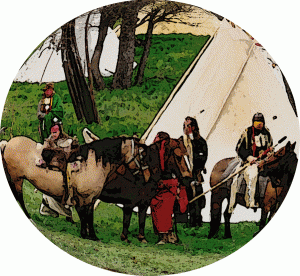
This image is a work in progress. It displays Cheyenne warriors talking before setting out to hunt. Although I may use it in a publication someday, I am almost 100 percent certain that it won’t see print in Sand Creek and the Tragic End of a Lifeway. But then again, who knows? (art © Louis Kraft 2014)
This leads to creating art for publication, which can lead to multiple printings in various formats (and extra cash). Of course there is a downside. Sometimes snide critics frown upon a writer using art that he created in his written works. I guess they support the system of using often used images (which is unfortunately the case) one more time as opposed to adding something new to a publication. I’m big on collages too, for collages count as one image in book or magazine form. More important, they can visually support the text and add value to the printed work. Another no-no? Probably, but I’ve moved beyond nitpicks that are based upon a long in-place vision on how nonfiction should be presented.
Currently I’m considering using art for illustrating Sand Creek and the Tragic End of a Lifeway. When I restored and fine-tuned (with documented permission from the various archives) all the images and photos for my submission to the University of Oklahoma Press for Ned Wynkoop and the Lonely Road from Sand Creek, my friend and editor-in-chief Chuck Rankin told me that I didn’t need to do this. Moreover, he said that he wanted his writers to write. I ignored him. If he reads this blog I hope he’s sitting. That said, Chuck, at the moment the above is just a consideration for the image delivery. Will it happen? Probably not. Of course I’m a firm believer in never saying “never.”
When it comes to writing progress is king
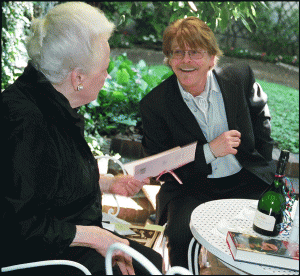
Celebrating Olivia de Havilland’s 93rd birthday in her Paris garden on July 3, 2009 (her BD is on July 1). She is a pure joy to know: Bright, funny, sexy, political, and oh-so caring. In this image she is looking at her birthday card. Two of her gifts are on the table (others included flowers, photos, and various writing). As every time I’ve been with her, this day and evening did not disappoint. (photo © Louis Kraft 2009)
Errol & Olivia
At the moment Errol & Olivia lags behind. For those of you interested in this book on Ms. Livvie and Errol, don’t worry. It doesn’t matter how far I may fall behind in word count, for whenever I write the fingers dance over the keys. This book has two goals: Bring Mr. Flynn and Ms. de Havilland to life while detailing their life and times between 1935 and 1941. The manuscript includes a prologue and an extensive epilogue. I am attempting a biographical approach that I’ve never seen before. Most of the writing about Flynn and de Havilland in book form (fully 60 percent) is repeated cliché, by that I mean that often the tomes merely repeat what has already been written. Truths and errors, and sometimes out-and-out lies, are repeated over and over again. Flynn and de Havilland were not, as unscrupulous writers have proclaimed, who you think they were (or in OdeH’s case, as she is). This book, and the following book on EF, will be the best two books I write. Patience is the key.
The Discovery
As the readers of my blogs know, I have partnered with Robert S. Goodman, MD, to produce a malpractice novel. The Discovery is Bob’s story idea and Bob has done a lot of work on the plot, including creating first class medical and legal detail. My job is to wordsmith and bring the characters and plot to life.

Robert S. Goodman, MD, in his office on 30may2014. Bob & I had a good review/update meeting on May 28. We spoke on the phone on the 29th and per my request he was answering questions I had and reviewing the manuscript. I told I wanted additional photos of him and we agreed on the following day. On the 30th he had his review and answers ready for me. I have never partnered before, and I can’t tell you how happy that I have with Bob for I think that between us we can create a good novel. (photo © Robert S. Goodman & Louis Kraft 2014)
To do this I’m approaching it as if it were a thriller. That means that I must make the pages turn and hopefully prevent our readers from going to bed at night. For this type of writing to work, really work, and capture a reader’s imagination it must have a voice. To do this I’m using an approach I’ve never done before: I’m writing as I read and mark-up Bob’s text. Before each time I meet with Bob to discuss status, I read my current draft and edit and rewrite it. The early chapters have been rewritten twice and the latter chapters once to date. This process will continue as I work my way through Bob’s manuscript. On May 28 Bob and I met for the second time to discuss the manuscript’s current status and to ensure that we are in agreement on how I’m proceeding and re-imagining his characters and plot. Currently my draft of The Discovery is 236 pages, and there’s still a long ways to go before I have a completed first draft. But trust me for my goal is doable and will happen.
Sand Creek and the Tragic End of a Lifeway
As stated above work is ongoing on Sand Creek and the Tragic End of a Lifeway, and the month of May has seen the best research and writing to date.

OU Press Editor-in-Chief Chuck Rankin at the 2012 Western Heritage Wrangler awards in Oklahoma City. Chuck has always been there for me, and over the years he has had the patience to listen to me. He has taken the time to discuss matters in which we don’t agree and has given me the room to experiment and grow. Ned Wynkoop and the Lonely Road from Sand Creek was the runner up this year. (photo © Ownbey Photography 2012)
And, like The Discovery, the story is character-driven, and as such I’m approaching the writing as much as possible as if the story is a thriller. Obviously the writing can’t be totally that of a thriller, but the goal is again to not put the readers to sleep. Although this has been ongoing for a while a good portion of the text doesn’t reflect this yet. The reason is simple. Facts must be in place and hopefully as close as possible to what actually happened. If facts must be deleted or fixed there is no point in rewriting them until they are as close to truth as I can make them.
Fingers are crossed that the upcoming time spent digging through the George Bird Grinnell Papers at the Braun Research Library will prove to be a goldmine for my Cheyenne research.
**********
I hope the above provides an update to my writing progress and gives you at least a hint of my creative world. … There is only one constant in my life and that is Pailin. She is my life, and as a good friend of mine named Veronica Von Bernath Morra in Massachusetts said, “Pailin is your muse.” She is, and as long as I do everything possible to ensure that our relationship thrives and grows my writing will continue to thrive in its “golden age.” Reality? I don’t know. Probable? Bet on it.
A publicity blurb
The August 2014 Wild West magazine will reach newsstands in early June.
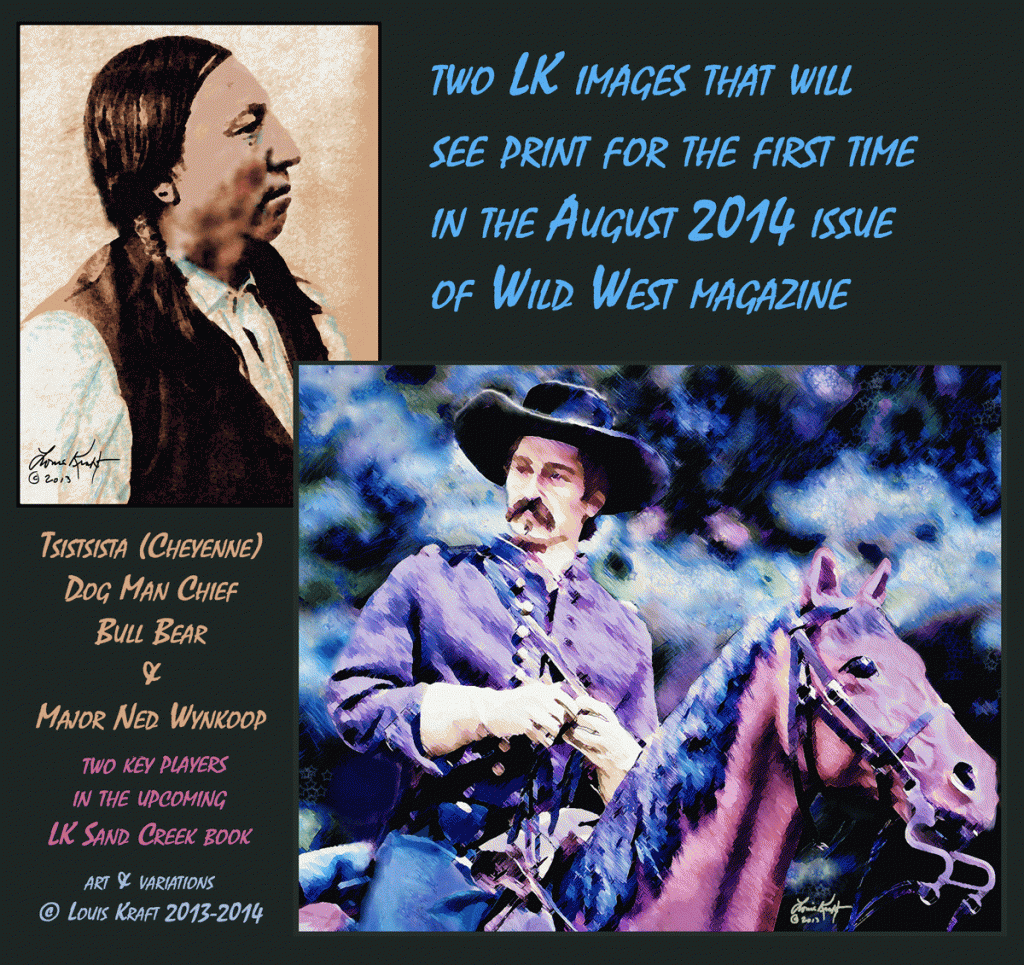
People often ask if I win all my battles with editors and art directors. The answer is, “No, I don’t.” I lost a big battle with the Wynkoop art, for the art director insisted that it could spread over two pages without affecting or destroying the reason why I created the painting. I fought to keep my art on one page but lost. I had the option to kill the article; yes, the anger directed at me was strong and hateful (and I had faced it in the past) but I didn’t want to do this and luckily production moved forward. I had given into what I knew would ruin the image I created, and unfortunately my previous 20+ years of design work proved correct. Egotistic incompetency would never survive in the software world (too much money is involved; for example, the cost of my documentation suite in the space world was $100 Gs). Wynkoop’s face is so close to the spine of the magazine that the curled brim of his hat is lost which destroys the effect of his dramatic gaze toward the Indian battle line. That’s life. There’s a big lesson here for me and believe me I will never forget it: The essence of the work is always more important than the money it can earn. Always. (art © Louis Kraft 2013)
Egotism aside, “Wynkoop’s Gamble to End War” is perhaps the best magazine article I’ve written. I pitched it to Greg Lalire in 2012, and he later pitched me on two short pieces for the August issue. I agreed as long as I could write what I wanted. “Must See, Must Read” is usually a plot summary of five films and five books. Greg agreed that I could deal with what the films and books meant to me. The other is ‘Wild West’s Top 10 List.” Usually this list is one column and less than a full top to bottom page. I counter pitched why Wynkoop was a major player during the 1860s Cheyenne wars, and he agreed to the idea. You know by now that I’m wordy. It’s two columns top to bottom of page and Greg needed to point to the Wynkoop/Gamble article to make it fit.
